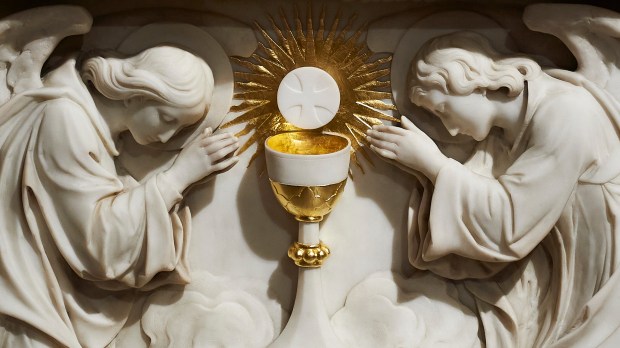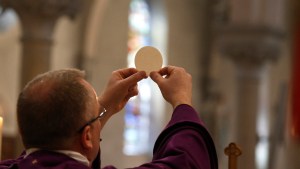The Catholic Church has believed since the time of the Apostles that Jesus is truly and substantially present in the consecrated Eucharistic host at Mass.
However, the practice of Eucharistic adoration, whereby individuals gaze lovingly at a consecrated host, did not develop until later.
Initially most hosts consecrated at Mass were consumed immediately, or were distributed to the sick and suffering. Tabernacles were rare and typically set off from the main church, not designed for individual devotion.
That all changed in the 10th and 11th centuries when an archdeacon in France publicly denied Jesus’ presence in the Eucharist.
This prompted an intervention from Pope Gregory VII and afterwards a type of “Eucharistic revival” occurred in France.
Fr. John Hardon describes what happened next in the book The History of Eucharistic Adoration:
With this profession of faith, the churches of Europe began what can only be described as a Eucharistic Renascence. Processions of the Blessed Sacrament were instituted; prescribed acts of adoration were legislated; visits to Christ in the pyx were encouraged; the cells of anchoresses had windows made into the church to allow the religious to view and adore before the tabernacle. An early ordinal of the Carmelites included the words “for the devotion of those in the choir” when referring to the reservation of the species.
Elevation of the host at Mass
Another major development that happened around the same time was the new practice of elevating the host after the words of consecration.
For much of Church history, the priest was accustomed to face the altar in the same direction as the people. This meant that when the priest was reciting the Eucharistic Prayer, the host and chalice were hidden from view.
Initially this did not pose any problem for the people, but by the 13th century, many saints were seeking ways to deepen the Eucharistic faith of the people.
The Catholic Encyclopediaexplains how this development started to spread:
At Paris, this elevation became a matter of synodal precept, probably before the year 1200. Before long it came to be regarded as a very meritorious act to look upon and salute the Body of the Lord. In this way, even before the middle of the thirteenth century, all kinds of fanciful promises were in circulation regarding the special privileges enjoyed by him, who, on any day, saw the Body of his Maker.
The institution of the feast of Corpus Christishortly after these events solidified the devotion of adoring Jesus in the Eucharist and has continued ever since in the Roman Rite of the Catholic Church.



